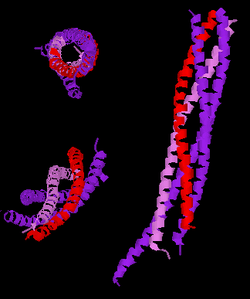Synaptobrevin
| Synaptobrevin-1 | ||
|---|---|---|

|
||
| 3 different views of the structure of an abbreviated neuronal SNARE complex. Legend: Synaptobrevin-2 (red), Syntaxin-1 (pink), SNAP-25 (purple). According to PDB 1N7S | ||
| Properties of human protein | ||
| Mass / length primary structure | 118 amino acids | |
| Secondary to quaternary structure | single pass type 4 membrane protein | |
| Isoforms | 3 (1A, 1B,?) | |
| Identifier | ||
| Gene names | VAMP-1 ; SYB-1 | |
| External IDs | ||
| Transporter classification | ||
| TCDB | 1.F.1.1.1 | |
| designation | SVF-Pore family | |
| Occurrence | ||
| Homology family | Synaptobrevin | |
| Parent taxon | Eukaryotes | |
| Synaptobrevin-2 | ||
|---|---|---|
| Properties of human protein | ||
| Mass / length primary structure | 115 amino acids | |
| Identifier | ||
| Gene names | VAMP-2 SYB-2 | |
| External IDs | ||
Synaptobrevins ( isotypes 1-2 ) are small essential membrane proteins of secretory vesicles with a molecular mass of 18 kDa . They belong to the family of vesicle-associated membrane proteins (VAMP) .
Synaptobrevin is one of the SNARE proteins that are involved in the formation of the SNARE complexes. One of the four alpha helices of the SNARE core complex is provided by Synaptobrevin, one by Syntaxin and two by SNAP-25 (in the neurons).
SNARE proteins are the core components of the molecular apparatus that drives membrane fusion in exocytosis . Their function is also supported by various regulatory proteins, collectively referred to as SNARE masters .
Since all proteins from the VAMP / Synaptobrevin family share common structural properties, they are classified as R-SNAREs . An alternative classification (V- and T-SNAREs) takes into account the origin of the synaptobrevin-bearing organelle instead of their structural properties.
Synaptobrevin plays an essential role in the release of the neurotransmitter acetylcholine and the associated conduction of excitation in the motor endplate of nerve cells . Even the presence of a single molecule of botulinum toxin (the strongest known poison) can break down synaptobrevin through its catalytic effect until the affected nerve cell is destroyed. The attached muscle fiber can therefore no longer be irreversibly controlled and can only be reactivated by the formation of new nerve cells.
Synaptobrevin is also destroyed by tetanus toxin . After minor injuries, this is produced by the tetanus bacteria that have entered or corresponding spores that mature into the bacteria, absorbed by peripheral nerves and transported retrograde into the spinal cord.
Cesare Montecucco was awarded the Paul Ehrlich and Ludwig Darmstaedter Prize for 2011 for his research on synaptobrevin .
literature
- M. Baumert, PR Maycox, F. Navone, P. De Camilli, R. Jahn: Synaptobrevin: an integral membrane protein of 18,000 daltons present in small synaptic vesicles of rat brain. In: EMBO J . 8, 1989, pp. 379-384. PMID 2498078
- JB Bock, RH Scheller: SNARE proteins mediate lipid bilayer fusion. In: PNAS . 96, 1999, pp. 12227-12229. PMID 10535902
- JA Ernst, AT Brunger: High resolution structure, stability, and synaptotagmin binding of a truncated neuronal SNARE complex. In: J Biol Chem . 278, 2003, pp. 8630-8636. PMID 12496247
- D. Fasshauer, RB Sutton, AT Brunger, R. Jahn: Conserved structural features of the synaptic fusion complex: SNARE proteins reclassified as Q- and R-SNAREs. In: PNAS. 95, m 1998, pp. 15781-15786. PMID 9861047
- T. Weber, BV Zemelman , JA McNew, B. Westermann, M. Gmachl, F. Parlati, TH Sollner, JE Rothman : SNAREpins: minimal machinery for membrane fusion. In: Cell . 92, 1998, pp. 759-772. PMID 9529252